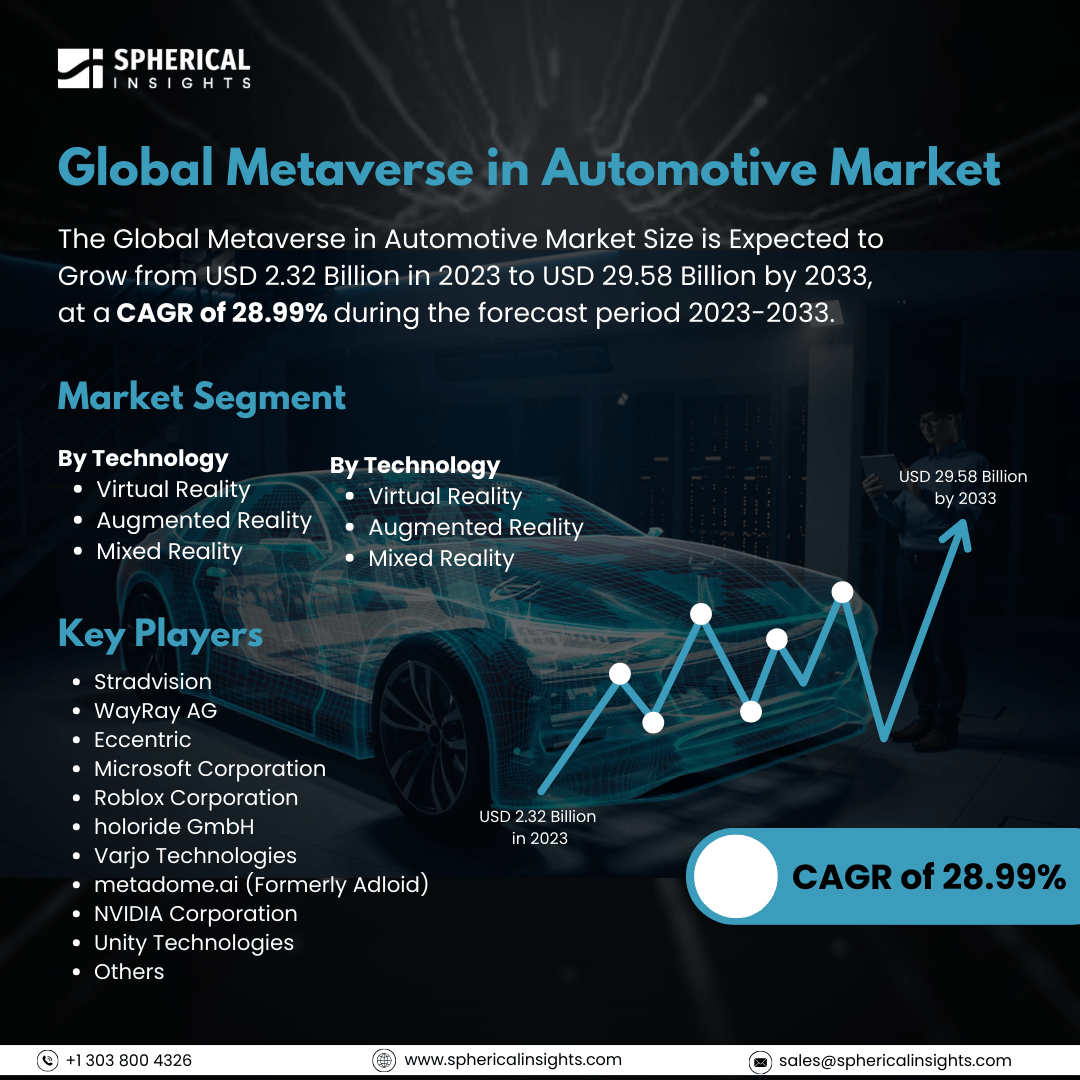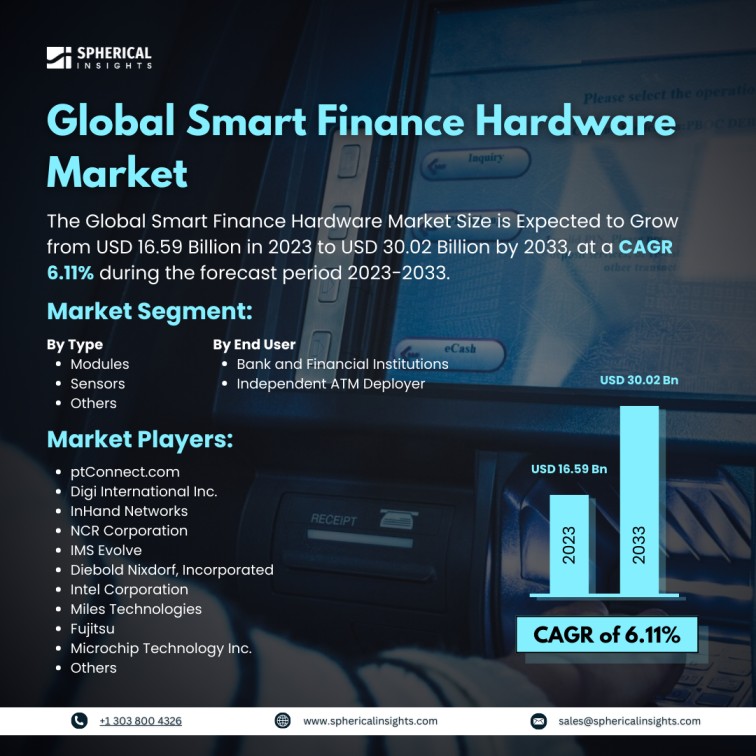Global Metaverse in Automotive Market Size to Exceed USD 29.58 Billion by 2033
According to a research report published by Spherical Insights & Consulting, The Global Metaverse in Automotive Market Size is Expected to Grow from USD 2.32 Billion in 2023 to USD 29.58 Billion by 2033, at a CAGR of 28.99% during the forecast period 2023-2033.
Browse 210 market data Tables and 45 Figures spread through 190 Pages and in-depth TOC on the Global Metaverse in Automotive Market Size, Share, and COVID-19 Impact Analysis, By Technology (Virtual Reality, Augmented Reality, and Mixed Reality), By Component (Hardware and Software), and By Region (North America, Europe, Asia-Pacific, Latin America, Middle East, and Africa), Analysis and Forecast 2023 – 2033
The incorporation of immersive technologies such as virtual reality (VR), augmented reality (AR), and mixed reality (MR) into the automotive ecosystem is referred to as the "Metaverse" in the automotive market. Through virtual representations and digital worlds, consumers can interact with, personalize, and experience automobiles, services, and other automotive-related activities. The use of the Metaverse for creative marketing efforts is rapidly expanding in the car sector. Conventional advertising strategies are changing as customers get more tech-savvy. Automotive firms may develop immersive and interactive marketing campaigns that engage consumers more deeply by utilizing the Metaverse. Such initiatives draw attention, increase brand recognition, and establish deep emotional bonds with the audience by fusing virtual and real-world events. Additionally, even in the car industry, contemporary consumers are looking for individualized experiences and ease. Customers want to examine and engage with cars in a dynamic digital environment, which is driving up demand for immersive virtual showrooms. Before making a purchase, prospective customers can virtually customize, check, and even test drive cars in these showrooms. This pattern fits nicely with the move toward digital-first strategies, enabling automakers to offer a fun, round-the-clock car-buying experience that suits tech-savvy customers' tastes. However, the exclusion of low-income groups and geographically underprivileged areas due to the high cost of advanced components results in additional disparities in access to technology, which impedes market expansion.
The virtual reality segment held the highest share in 2023 and is anticipated to grow at a significant CAGR during the projected timeframe.
Based on technology, the global metaverse in automotive market is categorized as virtual reality, augmented reality, and mixed reality. Among these, the virtual reality segment held the highest share in 2023 and is anticipated to grow at a significant CAGR during the projected timeframe. The rapid rise of virtual reality (VR) platforms is expected to promote the growing usage of VR platforms in the development of in-car reality entertainment systems.
The software segment held the highest share in 2023 and is anticipated to grow at a significant CAGR during the projected timeframe.
Based on the component, the global metaverse in automotive market is categorized as hardware and software. Among these, the software segment held the highest share in 2023 and is anticipated to grow at a significant CAGR during the projected timeframe. The capacity to produce real-time digital 3D representations of items and components, together with the increasing usage of gaming software as a tool for designing new cars, are important drivers anticipated to propel revenue growth in this market going forward.
North America is projected to hold the largest share of the global metaverse in automotive market over the forecast period.
North America is projected to hold the largest share of the global metaverse in automotive market over the forecast period. This is due to a number of factors, including growing acceptance of virtual reality, augmented reality, and mixed reality platforms, increased research and development efforts to advance these platforms, increased use of metaverse to view vehicles and easily connect with vehicle manufacturers, and a strong presence of major automotive companies in the region, North America is anticipated to have the largest revenue share during the forecast period.
Asia-Pacific is expected to grow at the fastest CAGR growth of the global metaverse in automotive market during the forecast period. The primary factors propelling this region's leadership include the quick digital change in nations like China and India, as well as consumers' growing interest in electric cars and immersive virtual worlds. With government-supported programs for digital innovation, the booming car industry is very keen on integrating metaverse technologies into the business.
Company Profiling
Major vendors in the global metaverse in automotive market are Stradvision, WayRay AG, Eccentric, Microsoft Corporation, Roblox Corporation, holoride GmbH, Varjo Technologies, metadome.ai (Formerly Adloid), NVIDIA Corporation, Unity Technologies., and Others.
Key Target Audience
- Market Players
- Investors
- End-users
- Government Authorities
- Consulting and Research Firm
- Venture capitalists
- Value-Added Resellers (VARs)
Key Market Developments
- In July 2022, Volvo Cars' electric vehicle (EV), Volvoverse, was first introduced in the metaverse by Mindshare India, which also featured the Volvo XC40 Recharge in a virtual environment.
Market Segment
This study forecasts revenue at global, regional, and country levels from 2020 to 2033. Spherical Insights has segmented the global metaverse in automotive market based on the below-mentioned segments:
Global Metaverse in Automotive Market, By Technology
- Virtual Reality
- Augmented Reality
- Mixed Reality
Global Metaverse in Automotive Market, By Component
Global Metaverse in Automotive Market, By Regional
- North America
- Europe
- Germany
- UK
- France
- Italy
- Spain
- Russia
- Rest of Europe
- Asia Pacific
- China
- Japan
- India
- South Korea
- Australia
- Rest of Asia Pacific
- South America
- Brazil
- Argentina
- Rest of South America
- Middle East & Africa
- UAE
- Saudi Arabia
- Qatar
- South Africa
- Rest of the Middle East & Africa



